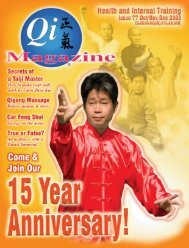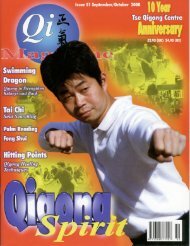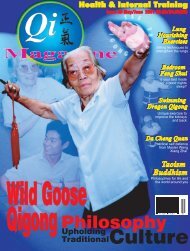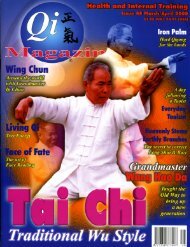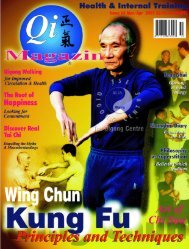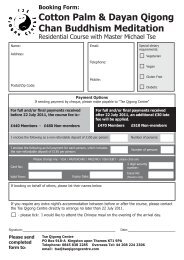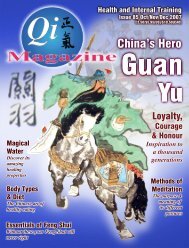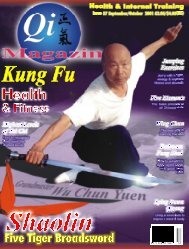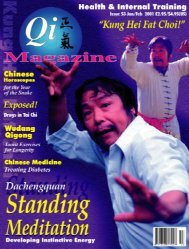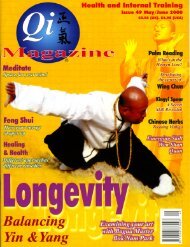You also want an ePaper? Increase the reach of your titles
YUMPU automatically turns print PDFs into web optimized ePapers that Google loves.
Taiji and Concepts of MovementIt is extremely rare to see someone moving with completeco-ordination, focus and relaxation. Very few people move inthis way but more importantly such movements are sounobtrusive that they easily escape the attention of the eye.Taiji sets out to train the body to movein ways that are completely alien toWestern convention. It is not just thatwhen one part of the body moves the wholebody moves with it. It is perhaps even amistake to consider movements in terms ofthe individuated body.Western analysis tends towardssegmentation and division. We tend to viewmovements quite mechanically. Newtonianphysics is still the foundation on which webase our understanding. Typically, movementis explained in terms of effort, resistance,levers and starting points.Such an analysis has allowed the Westto understand and refine particular kinds ofmovement, such as those in traditionalOlympic sports - running, throwing, etc. Itis a powerful tool and it has allowed the Westto quickly come to terms with the principlesof ‘hard’ martial arts like Karate.Such hard arts can effectively beanalysed in terms of simple mechanics. Youhave a starting point for the movement and afinal point of contact/impact. The mainconcerns are the speed of the movement andthe most efficient means of delivering themaximum power. This kind of analysis isparticular. It isolates an individual movement(occasionally it might examinethe way that movementsinterrelate but usually onlyin terms of how oneseparate, individual movement providesa good basis from which tolaunch the next separate, individualmovement). With this form ofanalysis the target might as well be, and oftenis, a static piece of wood. Interest in, andunderstanding of, the target is often definedin terms of the ability to break it. There isnothing wrong with such forms of analysisin so far as it goes.Many students’ push hands could beenormously improved by a rigorousmechanical analysis of the application ofstrikes, locks and throws. A basicunderstanding of the structure of theskeleton, tendons and musculature isessential for any serious martial artist.However, if you want to develop your taijito higher levels you will also need to developother concepts of movement than those thatseek to break it down into discreet units witheasily identifiable beginnings and ends.These concepts define movementless in relation to a point of leverage or astarting point than as an entry into an existingflow. Taiji is notconcerned just with themost efficient way ofdelivering the maximumforce in the form of animpact. The mostimportant part of Taiji’smartial strategy is theway that you merge withthe other person’smovement. In this senseTaiji has more incommon with surfing orhang-gliding than a sportlike boxing.In surfing thesurfer is not the sourceof the movement, thesurfer has to enter into arelationship with anexisting wave. How, why,and where the wavestarted moving isirrelevant to the surfer. Its source could befive miles out to sea, ten miles out to sea, orthe moon. It really does not matter. Thekey point is how to get taken up in themovement of the wave and this depends onobservation and sensitivity. You have to feelthe energy, speed, force and direction of themovement. Of course, Taiji does a little morethan simply ‘surf’ the opponents movements;but the little more that it does would not bepossible without sensitivity to the energy,speed, force and direction of movement.The way that a flow sustains itself isby moving in a circle. Within the cycle ofthe circle there are points at which the circlecan logically extend itself into a spiral or anellipse. There are sections of the ellipse thatcan behave and look like a line but thedifference is that an ellipse returns withoutstopping, while the line has an end point andcan be over-extended or broken (which iswhat happens if you make your arm into aline). The key to all of this is understandingwhere the limits of the circle are, and that isachieved through practice.To raise the level of your taiji involvesunderstanding the ever more subtledifferentiations between yin and yang andhow to merge with the flow as they changefrom one to the other. In push hands youhave to learn how to merge with the flow ofan opponent with the practice of the formleading to even greater sensitivity: sensitivityto the yin and yang movements of the form,sensitivity to the yin and yang movements ofbody and breath. Finally, with enormouspatience, perhaps your movements canmerge with the yin and yang flow of theuniverse at which point perhaps it is not youthat is moving at allby Glenn GosslingQi Magazine 7



